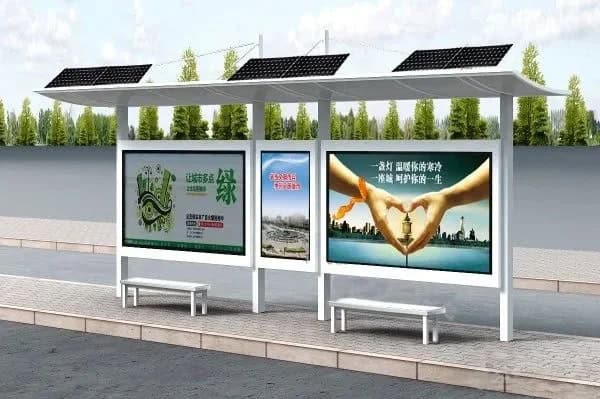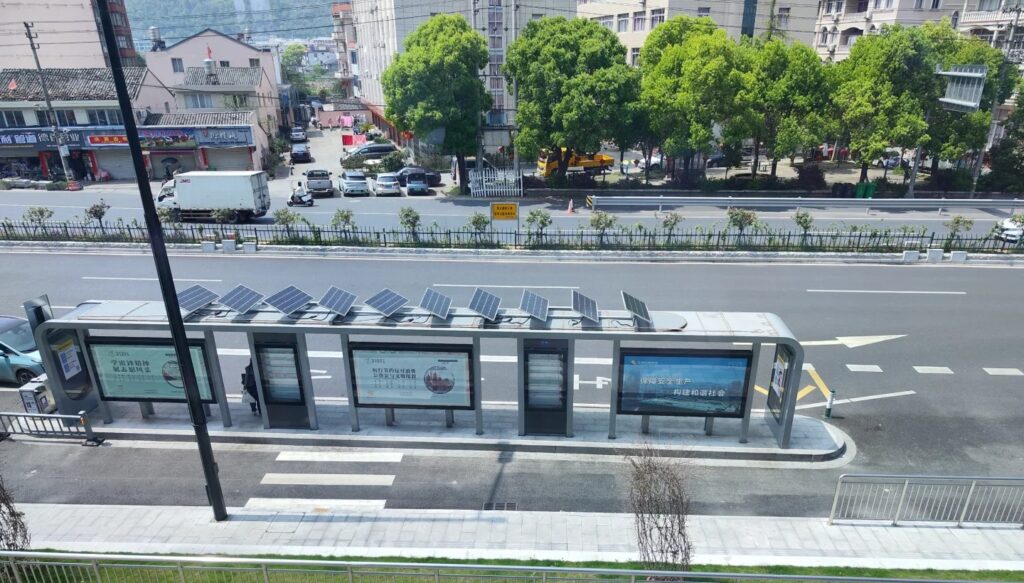Public transit infrastructure is evolving—and not fast enough. As cities face rising energy costs, carbon reduction mandates, and growing demand for smarter urban mobility, even something as ordinary as a bus shelter is being reimagined.
A solar bus shelter is no longer just a stop with a roof and a bench. It’s a self-powered micro-infrastructure unit, designed to deliver lighting, data, safety, and services—without touching the grid.
But what does that really mean in practice? Who stands to benefit? And is it a viable solution for your city, project, or region?
In this article, we go beyond definitions. We’ll explore how solar bus shelters work, where they make the most impact, and why they’re becoming a practical, scalable tool for building smarter, cleaner, and more resilient transit systems.
What to Expect in This Blog:
What Exactly Is a Solar Bus Shelter?
A solar bus shelter looks similar to a regular bus stop—but it does much more. Instead of just offering shade and a place to wait, it uses solar panels to generate its own electricity. These panels are usually installed on the roof, where they capture sunlight during the day.
You might be wondering: Why add solar panels to a bus stop? The answer is simple—power. A solar bus shelter can run lights, digital screens, USB charging ports, and even security cameras, all without connecting to the city grid. This makes it ideal for remote locations or areas with limited infrastructure.
In short, a solar bus shelter is a self-powered, energy-efficient upgrade to the traditional shelter. It improves safety, comfort, and visibility for commuters—while also supporting sustainable urban development.

Why Would You Use a Solar Bus Shelter Instead of a Traditional One?
Traditional bus shelters often fall short in real-world conditions. Maybe you’ve seen them—dimly lit at night, disconnected from any power source, or sitting idle in remote areas with no real function beyond shade.
No power means no lighting, no security, no updates.
In many places, running electrical cables to a shelter is costly or simply not practical. As a result, shelters are left without basic features like lighting, digital displays, or surveillance. This can make commuters feel unsafe—especially after dark.
Operating costs keep rising.
Even where power is available, electricity and maintenance add up over time. Cities and transit operators are under pressure to reduce spending while improving services. A traditional shelter just doesn’t offer much flexibility.
Cities are expected to be smarter—and greener.
Public expectations have changed. People want clean energy, smart infrastructure, and modern urban spaces. A standard shelter can’t meet those expectations, and doing upgrades later is often expensive.
This is where a solar bus shelter makes a difference. It solves all of these issues at once:
- It generates its own power
- It brings lighting, safety, and connectivity
- And it helps build a smarter, more sustainable public space
In short, it turns a passive structure into something active—something that works better for both people and the city.
How Is Solar Power Actually Used in the Bus Shelter?
You might be wondering: If a shelter has solar panels, what exactly do they power? And is it reliable? Good questions—and the answers are surprisingly simple.
Solar bus shelters are designed to be efficient and self-sufficient. The panels, usually mounted on the roof, collect sunlight during the day and send that energy to a battery system hidden inside the structure. That stored energy is what keeps the shelter running—even after the sun goes down.
So, what does the power actually support?
- LED lighting for better visibility and nighttime safety
- Digital displays showing bus arrival times or announcements
- USB charging ports for passengers
- Surveillance cameras to monitor the area
- In some cases, even public Wi-Fi or environmental sensors
The system usually includes a smart controller that manages energy use, so power is distributed efficiently throughout the day and night. If there’s not enough sun for a few days, the battery still keeps basic functions going. In certain locations, the shelter can even be connected to the grid as backup—but in many cases, it’s completely off-grid.
From a user’s point of view, the experience feels seamless. Lights turn on automatically at night. Screens update in real time. And all of it happens without needing cables or external power.
So yes—solar power in a bus shelter isn’t just a concept. It’s practical, tested, and already in use in cities worldwide.
Where Does It Work Best — And Where Might It Not?
Solar bus shelters work well in many places—but not everywhere. If you’re thinking about installing one, it’s important to consider the actual conditions on-site.
So where do they work best?
They’re ideal for areas with good sunlight exposure, especially locations that are hard or expensive to connect to the grid. Think of:
- Highways or rural roads
- Industrial zones or campuses
- Developing neighborhoods without full infrastructure
- Parks, tourist spots, or off-grid transit points
In these cases, a solar-powered shelter avoids trenching, wiring, and monthly electricity bills—while still delivering lighting, safety, and smart features.
And where might they not be the best fit?
If the shelter will be placed in a densely shaded area—for example, under tall buildings or heavy tree cover—solar performance may drop significantly. Also, in regions with very limited sunlight during winter months, backup systems may be needed to ensure 24/7 operation.
That doesn’t mean solar is off the table—it just means you might need a hybrid setup, combining solar with grid power or using higher-capacity batteries.
In most urban or semi-urban environments, solar bus shelters can be a strong option. But like any solution, they work best when the site matches the system. If you’re unsure, a quick site assessment can usually give you the answer.
Who Benefits from Installing a Solar Bus Shelter?
A solar bus shelter may look simple from the outside—but its value reaches far beyond the structure itself. It benefits everyone involved in public transport, from commuters to city planners.

Commuters get a better experience.
For daily passengers, the difference is immediate: lighting at night, real-time updates, and even the ability to charge a phone while waiting. The shelter feels safer, more comfortable, and more connected to the city around them.
Transit authorities reduce costs and improve services.
With solar power, shelters can operate without ongoing electricity bills or expensive wiring. That means lower maintenance costs and more flexibility when planning new routes—especially in areas where power access is limited. It’s also easier to deploy shelters quickly, without waiting for grid infrastructure.
Cities and municipalities gain visibility and progress.
Solar shelters are more than infrastructure—they’re a public signal of a city’s commitment to clean energy and smart mobility. They help cities meet sustainability goals, attract environmental funding, and build a modern, forward-looking image.
Contractors and developers get scalable, flexible options.
For project managers and EPC contractors, solar shelters reduce on-site complexity. There’s no need to coordinate with utility providers, and installations can be faster. Modular steel structures also allow for customization and easy integration into different urban or rural settings.
In short, a solar bus shelter creates value at every level—for people, for planners, and for the planet. It’s not just a shelter; it’s part of a smarter public transport system.
What Is It Made Of — and How Strong Is It?
If you’re going to install a shelter out in the open—for years—you want to know it’s built to last. That’s a fair concern.
A solar bus shelter isn’t just a glass roof with solar panels on top. It’s a structural system, designed to handle wind, rain, sun, and even snow—depending on the region.
Most modern solar shelters are built using:
- Steel frames for core structural strength
- Tempered glass or polycarbonate panels for roofing and side protection
- Anti-rust coatings and finishes to protect against corrosion
- Integrated solar mounting systems to secure panels safely in place
The steel frame is usually galvanized or powder-coated, offering durability and weather resistance with minimal maintenance. Some structures are modular, meaning they can be adapted in size or design without losing stability.
And yes—if designed properly, a solar shelter can handle high winds, heavy rain, and even snow loads. The key is proper engineering based on local conditions. A coastal city may need extra corrosion resistance. A snowy region may require stronger roof loads. That’s where customization comes in.
A well-built solar bus shelter isn’t just sustainable—it’s sturdy, weatherproof, and ready for long-term public use. You don’t have to trade strength for innovation.
Further Reading:
How a Solar Bus Shelter Is Made: Step-by-Step Guide
Is This a Scalable and Smart Choice for Future Cities?
Across the world, cities are being reshaped by urgent pressures: population growth, energy transition, and the demand for smarter public infrastructure. Urban planners are expected to do more—with less. And public transport is increasingly seen not just as a service, but as a platform for innovation, sustainability, and data connectivity.
In this context, even something as simple as a bus shelter becomes a strategic opportunity.
Solar bus shelters offer a way to scale smarter infrastructure without waiting for massive capital projects. They are small, modular, and easy to deploy—but they speak to bigger goals:
- Supporting clean energy adoption
- Reducing carbon emissions from public services
- Improving safety, equity, and accessibility in urban space
- Extending digital infrastructure into everyday public environments
They can act as decentralized micro-nodes—not only providing shelter, but powering lighting, data displays, cameras, Wi-Fi, or even air quality sensors. For cities aiming to build more resilient and responsive systems, this flexibility matters.
And because they operate off-grid, they can reach places that are often left behind—rural routes, underserved neighborhoods, or developing transit corridors.
Solar bus shelters are not just about today’s needs. They are a way to embed long-term intelligence, sustainability, and inclusiveness into the urban landscape—one stop at a time.
Final Thoughts: A Small Structure with a Big Impact
A solar bus shelter may seem like a minor upgrade—but it represents a major shift in how we think about public space.
It answers everyday needs—light, safety, connectivity—while quietly pushing forward the bigger goals of clean energy, smarter infrastructure, and more inclusive urban design. It doesn’t demand a city-wide overhaul. It doesn’t wait for perfect conditions. It simply works—with what you already have.
For any city, agency, or project leader looking to do more with less, this is not just a shelter. It’s a signal of progress, visible at street level.
Ready to Make Smarter Transit a Reality?
You don’t need a massive budget or a citywide overhaul to make visible, measurable progress. A solar bus shelter is a smart, scalable solution—ready to reduce costs, meet sustainability targets, and improve public experience from day one.
At SteelPRO PEB, we deliver structural strength, solar integration, and full technical support—designed for real urban conditions.
Let’s build infrastructure that works—and speaks for itself.
Explore our Solar Bus Shelter Solutions →
Or contact our team for a free consultation and tailored design proposal.

